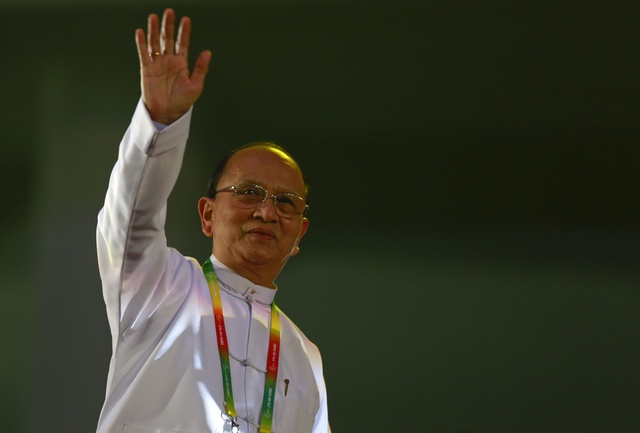Shortly after newly elected President Htin Kyaw completed a swearing-in ceremony in Burma’s parliament on Wednesday morning, the country’s new leader, a “proxy” of National League for Democracy leader Aung San Suu Kyi, headed to the Presidential Residence in Naypyidaw.
In its stately diplomatic hall, Htin Kyaw met outgoing President Thein Sein. An aired video recording of the hand-over ceremony shows Thein Sein, silent and emotionless, give his presidential sash to his successor and quickly exit the building.
It was a quiet event that marked the end of the historic and tumultuous five-year presidential term of Thein Sein. He was believed to have been handpicked by former military supremo Than Swe to carry out Burma’s democratic transition under quasi-civilian rule.
Thein Sein’s presidency has drawn mixed reviews, with most observers acknowledging its dramatic democratic reforms, while many criticise its continued repression, outbreaks of communal violence and conflict, and limited socio-economic progress.
‘Myanmar Spring’
“This was ‘Myanmar Spring, Burma Spring’,” Zaw Htay, the director of the President’s Office, said in a recent interview, favourably comparing Thein Sein’s reforms and smooth handover of power with the violence that followed the “Arab Spring” revolutions in the Middle East.
“The president had to accommodate [the interests of] the old [military] era and also create a new era. He was the leader during this very difficult transitional period,” Zaw Htay said. Without elaboration, he added that Thein Sein was able to carry out reforms for only two of his five years in office.
The remarks raise questions about whether the retired dictator Than Swe or current army chief Senior-General Min Aung Hlaing put the brakes on further reforms by the Thein Sein government.
Thein Sein will continue to function as chairman of the army-backed Union Solidarity and Development Party, which he represented as president following the party’s win in a rigged 2010 election.
When he took office, he declared in his inaugural public speech in 2011, that he would fight corruption, reform the judiciary, introduce democratic reforms and boost the economy to raise livings standards of Burma’s people. He subsequently freed thousands of political prisoners and initiated a nationwide ceasefire process to end long-running civil conflict.
Conflict and violence
Yet, his term also saw the break-down of a long-standing ceasefire with the ethnic Kachin rebels, continued clashes with other rebel groups in northern Shan State, and outbreaks of inter-communal violence between Buddhists and the Muslims in Arakan State and central Burma. Tens of thousands of civilians were displaced during the violence and conflict that occurred during his term.
No sooner had the number of political prisoners dipped than a new class of them emerged, this time mostly activist students calling for education reform and farmers resisting a rise in land confiscations, another hallmark of Thein Sein’s term. Early on, in November 2012, a violent crackdown on a protest against an unpopular, China-backed copper mine in Sagaing Division had already raised doubts about his government’s commitment to freedom of expression.
“If we have to distinguish between the bad things and the good things of President Thein Sein’s term, then we would have to say that all the good things he did in the first two years were overshadowed by the bad things that followed later,” said Mya Aye, a former political prisoner and member of the influential 88 Generation Peace and Open Society activist group.
Matthew Burgher, a lawyer with Thailand-based human rights group Fortify Rights, said, “It’s undeniable that [Burma] is a freer and more open country and its citizens now have great hope for the future. Thein Sein’s name will forever be associated with this period of dramatic reform.”
But, he added: “Thein Sein’s legacy will be permanently tarnished by his government’s active undermining of fundamental rights and freedoms. In particular, the continued crackdown on activists, which accelerated at the end of his term, and the systematic persecution of Rohingya” Muslims in Arakan.
Economic progress
On the economic front, Thein Sein successfully reengaged with international financial institutions such as the World Bank and IMF. With it came access to aid and loans, and a slashing of Burma’s massive debts. Other reforms saw him open up some sectors of the economy for international investors, most notably oil and gas, and telecoms. GDP growth and foreign investment figures jumped.
[related]
In terms of achieving his publicly stated goals of raising living standards of Burma’s population, however, there were few achievements, according to Sean Turnell, an Australian economist who specialises in Burma and advises the NLD.
“Indeed, given rising prices, land insecurity and a society more aggressive in its pursuit of material gain, considerable numbers of people in [Burma] are worse off at this conclusion of the Thein Sein government than they were at its commencement,” he told Myanmar Now in an email.
“Overall, the Thein Sein government laid down some good foundations, but these have not been sufficient to build the structure of change needed to improve the lives of the Burmese people. Accordingly, his legacy is a mixed one, and has left the new government a heavy burden,” Turnell said.



